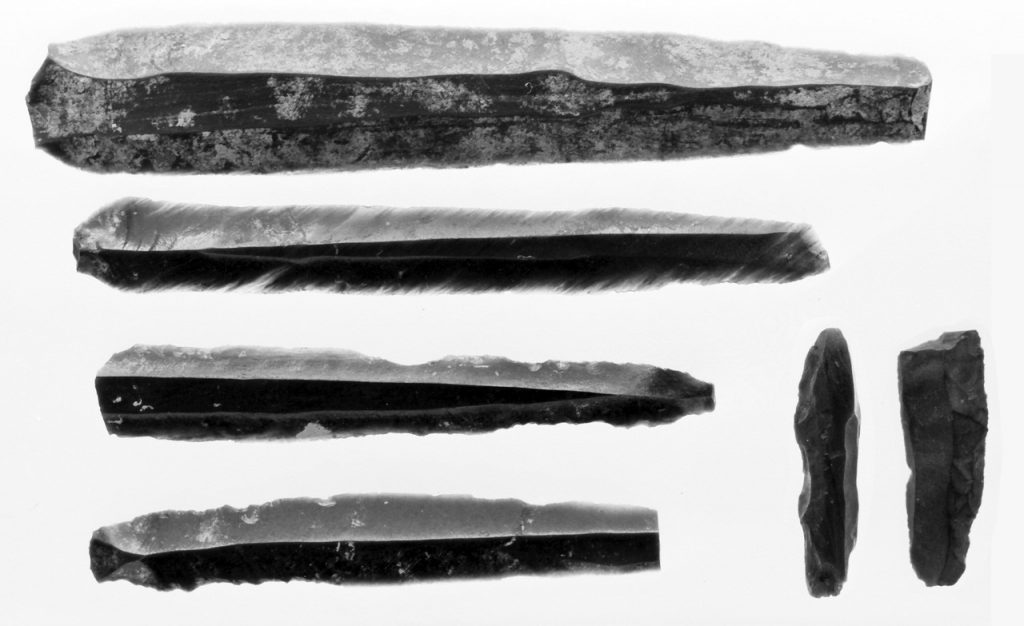Marble was worked mainly with stone tools. Although no direct evidence is available for the toolkit of the Cycladic craftsman, modern research in combination with experimental archaeology has shown that most tools were probably made of emery. A piece of this heavy and dense stone – which abounds in Naxos – can be easily turned into a mallet (for shaping the figure) simply by making its edge pointed or sharp. Emery was also probably used as a drill (to carve and pierce specific anatomical details such as the eye, ear, navel, and loin cavities, or repair holes), as an engraving tool (for incised details) or as a surface polisher. Emery powder was very effective as an abrasive for the initial working of the marble.
Obsidian – widely available on Melos – and flint may have also been employed in marble carving. When shaped into blades, those materials can be used as engraving tools or even for erasing the traces of smoothing on the surface of the marble; in the form of small pointy flakes they become particularly effective drills. Finally, Theran pumice soaked in water is an excellent material for the final polishing of the surface, and the same is true for sand mixed with water. Bronze chisels could have been used for greater precision and speed in making the cut-outs on more complex figurines, such as the harpists, although their poor durability (due to the high copper-content) as well as the high value of metals in that period, probably made metal stone-working tools less common.
As we can deduce from the few unfinished figurines that have been discovered so far, the first step in the process was to roughly shape the raw piece of marble into a figure by the impact of a mallet. Emery powder was then used to abrade the surface until it obtained the desired shape and size. Once the desired shape was achieved, the surface was smoothed carefully before the fine work of carving the details started. At the end, the figurine was polished to a high degree that is still amazing. Traces of horizontal, vertical or diagonal smoothing are very often visible on the surface of marble figurines. Sometimes, we can see the marks left by the tool used to level the contours of the leg cleft on “canonical” figurines. Traces of repairs are also discernible in some examples.
The creation of a Cycladic figurine was based on strict rules and a detailed system of proportions, which required precise measurements and considerable skill in application. Therefore, it was most likely the work of specialized craftsmen, who probably passed on their knowledge to younger artisans only after the latter had spent a long period of time working as apprentices. Some scholars have attempted to identify individual “artists” or workshops by distinguishing groups of figurines with similar characteristics. Those “artists” (or workshops) have been conventionally named after the museum or the city which hosts characteristic works by them, after the excavator who brought them to light, or after the collector who possesses them (e.g. the Berlin Master, the Doumas Master, the Goulandris Master, etc.). Other scholars, however, reject these attributions as anachronistic and believe that the similarities reflect chronological or geographical proximity. One should bear in mind that the available evidence for the techniques employed in Cycladic marble-carving is very fragmentary and our knowledge stems almost exclusively from careful observations of the figurines themselves. So far, no workshop has been discovered in a Cycladic settlement and the organization of the production remains entirely unknown.
Direct evidence for the working of bronze in the Cyclades is limited but instructive. Remains of hearths and crucibles of the Early Cycladic III period have been found at Kastri on Syros, together with slags and stone moulds which show that metal smiths knew how to cast bronze and produced both cast and hammered objects. The spread of metallurgy in the Aegean during the third millennium BC gave impetus to crafts such as building, shipbuilding, carpentry, and the minor arts; at the same time, it promoted trade and contributed to the development of social stratification. Mainly, however, it brought important changes in the techniques of warfare. Bronze weapons become relatively common in the Cyclades in the later stages of the Early Cycladic II period and this seems to be related to the disturbances and upheavals that are observed in the Aegean during the transition to the Early Cycladic III period. According to one theory, this turmoil was due to conflicts between local populations for the control of sources of raw materials, such as copper, or access to networks trafficking metals that were more difficult to obtain, such as tin.

